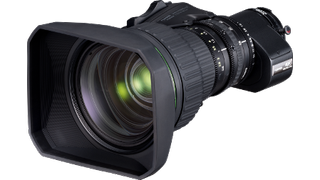Optimizing Lenses for HDR
SEATTLE—HDR (aka high dynamic range), needs no introduction. It’s had its rollout from consumers and the content creators. It provides greater contrast range, expanding what can be seen in the darkest and the brightest parts of an image. Content mastered and processed in HDR can be displayed on HDR-capable displays.

Fujifilm recently launched the UA24x, the latest zoom lens in the company’s Premier UA Series of 4K 2/3-inch lenses. The addition of this product expands Fujifilm’s 4K broadcast lens lineup to eight models in total, catering to the various needs for 4K HDR video production.
But what role do lenses play—if any—with HDR? After all, the light has to pass through the lens first, before hitting the camera sensor. Lensmakers say that HDR itself is made in the camera, but lenses do play a role.
THE RIGHT ENVIRONMENT
“The camera system, circuitry, whatever the design, is doing the HDR,” said Gordon Tubbs, vice president at Fujifilm North America Corporation, Optical Device Division. “But we can make an environment where the image we give to the camera makes it easier for the camera system to put out that beautiful HDR image.”
Larry Thorpe, national marketing executive at Canon USA Inc., looks first to HDR’s ability to see details in the darker parts of the scene. “The cameras have gotten better and better in going down [into darker parts of the scene] over the past decade,” he said. “And that says to the lens, ‘if the cameras are able to go down, you better go down, and don’t mess with deep blacks in the scene.’
“And lenses can mess with blacks,” Thorpe continued. “You can get flare, you can get veiling glares, you can get all sorts of nasty contamination of black, generally due to the reflections. As light travels through the lens, toward the camera sensor, that light that is carrying the useful information is reflecting off all the surfaces.” Thorpe pointed to multiple layers of proprietary coatings that lensmakers use to reduce these reflections.
Tubbs noted that for HDR “the first thing that we do to control the flare—that light bouncing around inside the lens—is a completely new inner barrel design, with baffles made with materials to basically trap that light.”
Canon has a barrel design, as well, with what it calls “flocking,” mechanical barriers to minimize reflections.
Lens errors like chromatic aberration become more apparent at the other end of the brightness spectrum—the brighter brights that HDR makes possible to display.
“It’s [an error] that HDR will enhance, to make it more visible, because HDR’s letting you see more detail in contrast and high-brightness scenes,” said Thorpe. “And you’ve probably seen where you get reproductions of the aperture, and you see multiple levels of it. And they can change color. These are what we call ‘optical aberrations’ created by unusually intense highlights. And if you’re trying to make beautiful HDR, you certainly don’t want those artifacts.”
CAPTURING THE DYNAMIC RANGE OF FILM
At the end of the day, said Tubbs, lensmakers are after “good-looking detail in the highlights as well as in the dark areas. That’s really what we’re aiming at with HDR.”
ARRI, a long-time maker of film cameras approaches HDR by referencing imaging in film, according to Sebastien Laffoux, vice president of camera systems sales for the company.
“HDR originated with film acquisition and electronic capture platforms have long wanted to match the dynamic range of film,” he said. “HDR in TV is only new from the standpoint of distribution.”
Laffoux adds that today’s state-of-the-art lenses are “good enough” to transmit the 14.5 stops of dynamic range that top-of-the-line cameras such as ARRI’s Alexa can deliver. “But to push beyond that, new lenses will be required,” he said.
HDR is not a panacea to all content creators, noted Laffoux. “This increased contrast capability is a departure from the traditional cinematic aesthetics,” he said. “Not everyone likes it, and the viewing experience varies greatly from TV set to TV set.”
Piet Thiele, product manager, Cine for lensmaker Schneider Kreuznach in Germany, isn’t hearing a demand for HDR from his customers who are shooting feature movies, commercials and such.
“They think about bringing down the resolution of the cameras, so skin tones and all that looks a little smoother, more creamy, more organic,” he said. “In cine, normally the director of photography wants these kinds of flare and ghosts and some sort of character inside the lens.”
Thiele allowed that there is a place for HDR in broadcasting, especially for live events such as sports. “When you want to do television, you want to see everything in the stadium as a viewer,” he said. They like the HDR approach because the audience wants to see the real world. But if you go to a movie theater, you want to see a story, and sometimes not the real world.”
One lensmaker who is marching in the opposite direction from HDR is Les Zellan, chairman of U.K.-based Cooke Lenses. Where the latest cameras may tout high resolution and high contrast, Zellan says that Cooke has struck the right balance of resolution and contrast “to give the picture more character.” He summarizes the company’s philosophy thusly: “Resolution is a standard engineers use to measure, not the standard that people use to say ‘wow, that was really a great movie, or a great TV show. It really looked great.’”
Cooke made a lens called the Speed Panchro for four decades before discontinuing it in the mid-1960s. The lenses used no coatings and were known for their reflection and flares. Based on DIP demand for the “Cooke Look” these old lenses provided, the company has reintroduced them as the “Panchro Classic,” based on a redesign that covers a super 35 frame. In addition, Cooke had to use some modern glass for the elements because not all the old glass was available.
Get the TV Tech Newsletter
The professional video industry's #1 source for news, trends and product and tech information. Sign up below.













